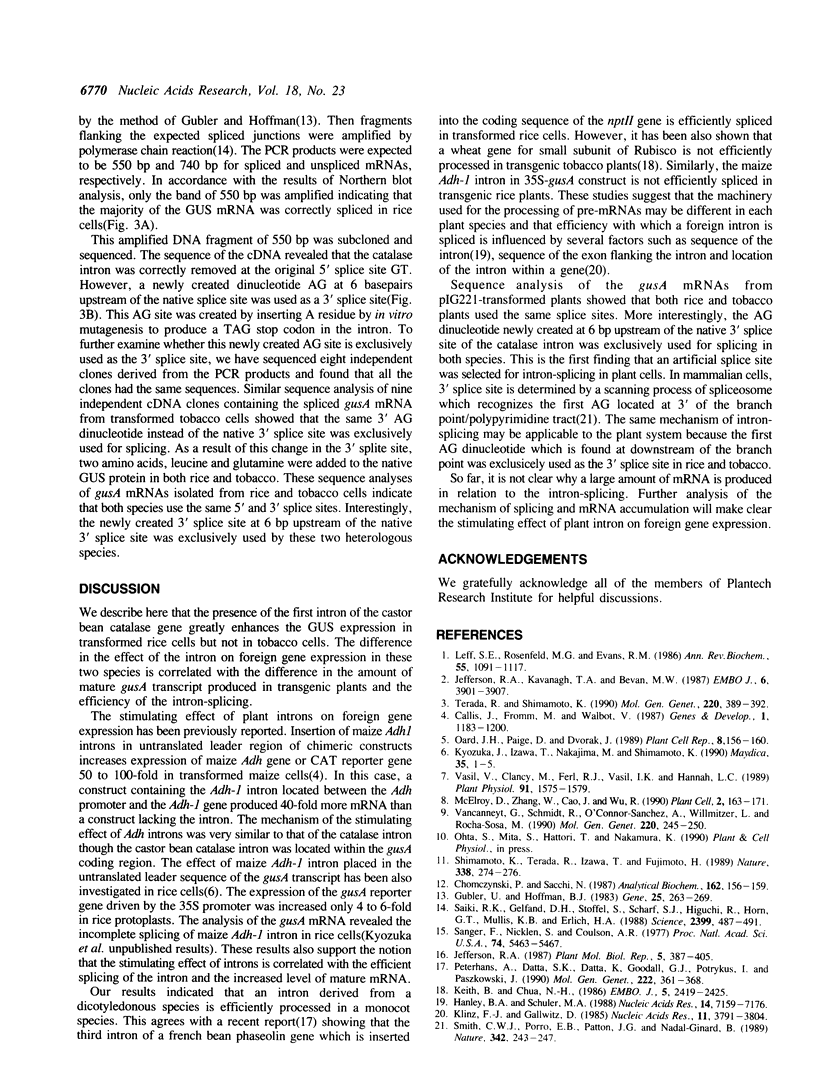Abstract
The first intron of castor bean catalase gene, cat-1 was placed in the N-terminal region of the coding sequence of the beta-glucuronidase gene (gusA) and the intron-containing gusA was used with the cauliflower mosaic virus (CaMV) 35S promoter. Using this plasmid, pIG221, the effect of the intron on expression of beta-glucuronidase (GUS) activity was examined in transgenic rice calli and plants (a monocotyledon), and transgenic tobacco plants (a dicotyledon). The intron-containing plasmid increased the level of GUS enzyme activity 10 to 40-fold and 80 to 90-fold compared with the intronless plasmid, pBI221, in transgenic rice protoplasts and transgenic rice tissues, respectively. In contrast, the presence of the intron hardly influenced the expression of the GUS activity in transgenic tobacco plants. Northern blot analysis showed that the catalase intron was efficiently spliced in rice cells while transgenic tobacco plants contained both spliced and unspliced gusA transcripts in equal amounts. Furthermore, the level of the mature gusA transcript in transformed rice calli was greatly increased in the presence of the intron. The catalase intron was removed at the same splice junctions in transgenic rice and tobacco plants. These findings indicate that the stimulating effect of the intron on GUS expression is correlated with an efficient splicing of pre-mRNA and an increased level of mature mRNA.
Full text
PDF



Images in this article
Selected References
These references are in PubMed. This may not be the complete list of references from this article.
- Callis J., Fromm M., Walbot V. Introns increase gene expression in cultured maize cells. Genes Dev. 1987 Dec;1(10):1183–1200. doi: 10.1101/gad.1.10.1183. [DOI] [PubMed] [Google Scholar]
- Chomczynski P., Sacchi N. Single-step method of RNA isolation by acid guanidinium thiocyanate-phenol-chloroform extraction. Anal Biochem. 1987 Apr;162(1):156–159. doi: 10.1006/abio.1987.9999. [DOI] [PubMed] [Google Scholar]
- Gubler U., Hoffman B. J. A simple and very efficient method for generating cDNA libraries. Gene. 1983 Nov;25(2-3):263–269. doi: 10.1016/0378-1119(83)90230-5. [DOI] [PubMed] [Google Scholar]
- Hanley B. A., Schuler M. A. Plant intron sequences: evidence for distinct groups of introns. Nucleic Acids Res. 1988 Jul 25;16(14B):7159–7176. doi: 10.1093/nar/16.14.7159. [DOI] [PMC free article] [PubMed] [Google Scholar]
- Jefferson R. A., Kavanagh T. A., Bevan M. W. GUS fusions: beta-glucuronidase as a sensitive and versatile gene fusion marker in higher plants. EMBO J. 1987 Dec 20;6(13):3901–3907. doi: 10.1002/j.1460-2075.1987.tb02730.x. [DOI] [PMC free article] [PubMed] [Google Scholar]
- Keith B., Chua N. H. Monocot and dicot pre-mRNAs are processed with different efficiencies in transgenic tobacco. EMBO J. 1986 Oct;5(10):2419–2425. doi: 10.1002/j.1460-2075.1986.tb04516.x. [DOI] [PMC free article] [PubMed] [Google Scholar]
- Klinz F. J., Gallwitz D. Size and position of intervening sequences are critical for the splicing efficiency of pre-mRNA in the yeast Saccharomyces cerevisiae. Nucleic Acids Res. 1985 Jun 11;13(11):3791–3804. doi: 10.1093/nar/13.11.3791. [DOI] [PMC free article] [PubMed] [Google Scholar]
- Leff S. E., Rosenfeld M. G., Evans R. M. Complex transcriptional units: diversity in gene expression by alternative RNA processing. Annu Rev Biochem. 1986;55:1091–1117. doi: 10.1146/annurev.bi.55.070186.005303. [DOI] [PubMed] [Google Scholar]
- McElroy D., Zhang W., Cao J., Wu R. Isolation of an efficient actin promoter for use in rice transformation. Plant Cell. 1990 Feb;2(2):163–171. doi: 10.1105/tpc.2.2.163. [DOI] [PMC free article] [PubMed] [Google Scholar]
- Peterhans A., Datta S. K., Datta K., Goodall G. J., Potrykus I., Paszkowski J. Recognition efficiency of Dicotyledoneae-specific promoter and RNA processing signals in rice. Mol Gen Genet. 1990 Jul;222(2-3):361–368. doi: 10.1007/BF00633841. [DOI] [PubMed] [Google Scholar]
- Saiki R. K., Gelfand D. H., Stoffel S., Scharf S. J., Higuchi R., Horn G. T., Mullis K. B., Erlich H. A. Primer-directed enzymatic amplification of DNA with a thermostable DNA polymerase. Science. 1988 Jan 29;239(4839):487–491. doi: 10.1126/science.2448875. [DOI] [PubMed] [Google Scholar]
- Sanger F., Nicklen S., Coulson A. R. DNA sequencing with chain-terminating inhibitors. Proc Natl Acad Sci U S A. 1977 Dec;74(12):5463–5467. doi: 10.1073/pnas.74.12.5463. [DOI] [PMC free article] [PubMed] [Google Scholar]
- Smith C. W., Porro E. B., Patton J. G., Nadal-Ginard B. Scanning from an independently specified branch point defines the 3' splice site of mammalian introns. Nature. 1989 Nov 16;342(6247):243–247. doi: 10.1038/342243a0. [DOI] [PubMed] [Google Scholar]
- Vancanneyt G., Schmidt R., O'Connor-Sanchez A., Willmitzer L., Rocha-Sosa M. Construction of an intron-containing marker gene: splicing of the intron in transgenic plants and its use in monitoring early events in Agrobacterium-mediated plant transformation. Mol Gen Genet. 1990 Jan;220(2):245–250. doi: 10.1007/BF00260489. [DOI] [PubMed] [Google Scholar]
- Vasil V., Clancy M., Ferl R. J., Vasil I. K., Hannah L. C. Increased gene expression by the first intron of maize shrunken-1 locus in grass species. Plant Physiol. 1989 Dec;91(4):1575–1579. doi: 10.1104/pp.91.4.1575. [DOI] [PMC free article] [PubMed] [Google Scholar]




